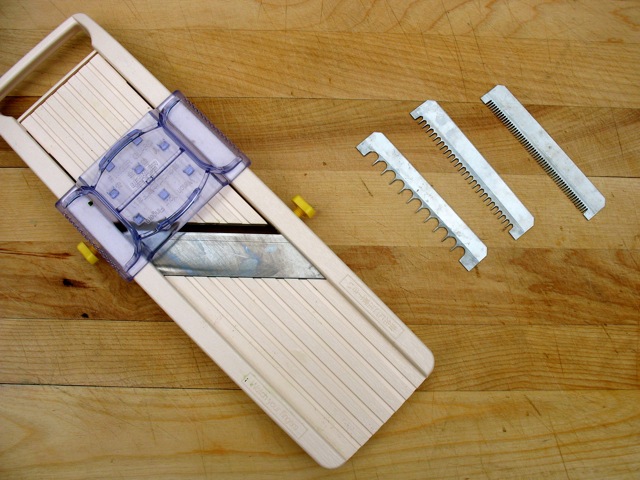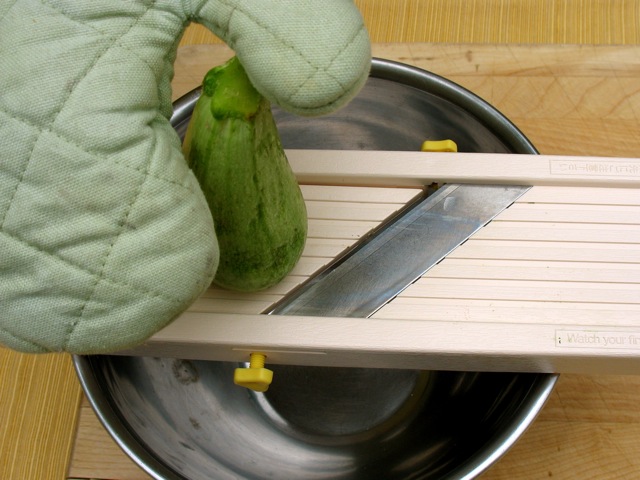
reference-image, l
(article, Kelly Myers)
[%pageBreakSettings nobreak=true] A razor-sharp mandoline may never make it onto your list of Tools You Simply Can’t Cook Without. You can certainly perform the cuts a mandoline makes — the thin slice, the julienne — with a chef’s knife. But can you make them as rapidly? Besides, there are times when you want a mathematical precision to your work that most people — serious sushi chefs excepted — cannot execute with a knife. [[block(sidebar). h1.Featured recipes]] Let’s pretend you’re eating out, right now. See those matchsticks of cucumber and carrot that you’re about to mix into your bowl of rice-stick noodles and charred lemongrass chicken? And when dessert is served, check out those identical slices of apple fanned out over the cream tart. Making food attractive is part of the art and craft of feeding others. Even if you care more about how your food tastes than how it looks, I bet you still want your vegetables to cook evenly when you stir-fry. Start using a mandoline, and they will. A mandoline is a handheld device on which you run vegetables or fruit over your choice of blades to make a slice, a julienne or matchstick, or even a waffle cut. The thickness of the slices and the width of the julienne are adjustable. I can make coleslaw that’s fine enough to cram onto a sandwich on my mandoline. Goodbye, thick, unwieldy pieces of cabbage. I can also surprise my family with salads of carrots as fine as threads, or beets in fat sticks instead of the usual wedges. (I have learned not to underestimate the power of uncommon presentation during root-vegetable season, or when I am wanting my four-year old to eat a vegetable.) [%image reference-image float=right width=400 caption="A Benriner mandoline, with interchangeable slicing blades."] For some, a French-made, heavy-duty, stainless-steel mandoline, such as the one made by Bron, is the only way to slice. The Bron could last a lifetime, but at $150 and up, it’s a serious kitchen investment. Many of us in the restaurant industry prefer the small, lightweight, Japanese-style mandoline, in which everything is plastic except for the blades. I have a Benriner, which I found at a Japanese grocery store for $30. We use two Benriners at the restaurant where I work, and their blades have stayed surprisingly sharp despite daily use. (Unlike knives, a mandoline’s blades never hit a cutting board.) Using a mandoline to slice or julienne a food can change how it cooks. Take potatoes, for example. The mandoline provides a thinner slice than you can, easily 1/8 inch thin or less. This matters when you are putting together a gratin. Potato gratins depend upon the potato starch to hold them together in neat layers. A potato sliced into more thin slices, rather than fewer thicker slices, exposes more cut-surface area, which releases more starch. Regular, thin slices also bake more quickly, so you are less likely to have the problem of the gratin absorbing all of its cooking liquid well before the potatoes cook through. I recently made two batches of zucchini fritters. For the first, I grated the squash on a box grater. This made fritters that were slightly mushy. The box grater’s crude cutting edges had crushed the zucchini, releasing its liquid and making the fritters too wet. This happened even though I had salted the zucchini and squeezed out the excess liquid. I switched to the mandoline for my second batch, using the medium-sized julienne blade. The resulting thin sticks of zucchini held their shape, thanks to a sharp cut. The fritters fried up crisper because they were less wet. And their edges took on an attractive, lacy look. On my Benriner, three interchangeable teeth-like blades make julienne strips from fine to coarse. You turn a screw to move the plate up and down, which positions the vegetable in front of the blade. Most mandolines have legs that position them like a slide, letting slices fall underneath onto your work surface. Other mandolines sit over plastic boxes, which catch the vegetables. Mine has neither, so I place it over a bowl. I hold the handle on one end while my other hand moves the vegetable across the blade. [%image feature-image float=left width=400 caption="Wear a thick glove to protect your fingers while slicing bulky foods."] Which brings us to safety. Almost every mandoline, except for the simple $6.95 slicer, comes with a finger guard. Finger guards are a plate or enclosure that comes between you and the item being sliced. You hold the guard as you guide the vegetable or fruit over the blade. The guard that came with my Benriner mandoline is simply a removable plastic plate with prongs on one side to secure the vegetable. As I slice, the guard hooks over the sides of the mandoline, where it slides smoothly. Other brands have hinged guards to accommodate pieces of various sizes. There is a serious problem with most finger guards and holders, though: There’s just no way they can hold the longer, bigger vegetables — the ones you are most likely to use on a mandoline — with absolute security. An unwieldy carrot or potato can easily slip, especially as you push to get it through the julienne blade. You need to find other ways to protect your hand. Use the guard when the food you are cutting is small enough for the guard to be effective. Generally, this is a thickness of 2 to 3 inches. The rest of the time — in other words, when you need to hold the fruit or vegetable directly — you should don a cut-resistant glove. Safety gloves are knit, so they’re flexible, not cumbersome. They’re used in restaurants and by meat cutters, and are available for $13 to $20 per pair. At home, I’ve found that a thick, clean oven mitt worn on my slicing hand works just as well. Still, I go slow and pay attention to what I’m doing. When you’re finished, wash and store your mandoline right away. You don’t want to have to scrub stuck-on bits from the blade, and you don’t want the mandoline’s exposed edge lying about. Use it safely and your mandoline will take you through the vegetable slaws of summer to the potato gratins of cold weather. You may start to find it indispensable. p(bio). Kelly Myers is a chef and writer in Portland, Oregon. She is also the co-director of Market Chefs, an organization dedicated to inspiring and teaching consumers to cook local foods.

reference-image, l

feature-image, l